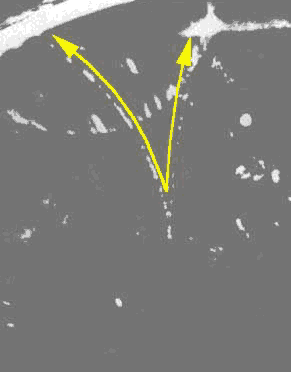This theory is what most people think about when they hear Einstein's name, though few people can say that they actually understand its significance. His theory sprang up after years of research and decades of experiments. What Einstein discovered was that there is a deep connection between mass and energy which is represented in the equation E = mc^2. In the equation E stands for energy, m for the mass, and c is the speed of light. Although it appears simple, this relationship has profound implications. Even an incredibly small mass will produce large amounts of energy because the constant c^2 is equal to 3x10^16 m/s!
The first photograph showing the conversion of energy into mass was taken by Irene and Frederic Joliot-Curie. The picture to the right shows a quantum of light changing into mass.
A wave file of Einstein explaining the equation
Einstein used this new theory to predict that when a ray of light passes near a massive body, that ray should be bent and that there would be a specific, measurable deflection during a solar eclipse. The next eclipse was predicted for 1919 just after the first world war had ended, and British astronomers jumped at the opportunity to verify the theory. The astronomers succeeded in photographing stars near the sun and just as Einstein had stated the starlight was deflected. His theory was helped in 1932 when Cockcroft and Walton proven experimentally that mass and energy were in fact equilivalent. Because of this powerful theory, a small amount of mass can be converted into a large amount of energy.
Nuclear Age
Early Life
Einsteinian wisdom
Einstein and society
More information
Back home

